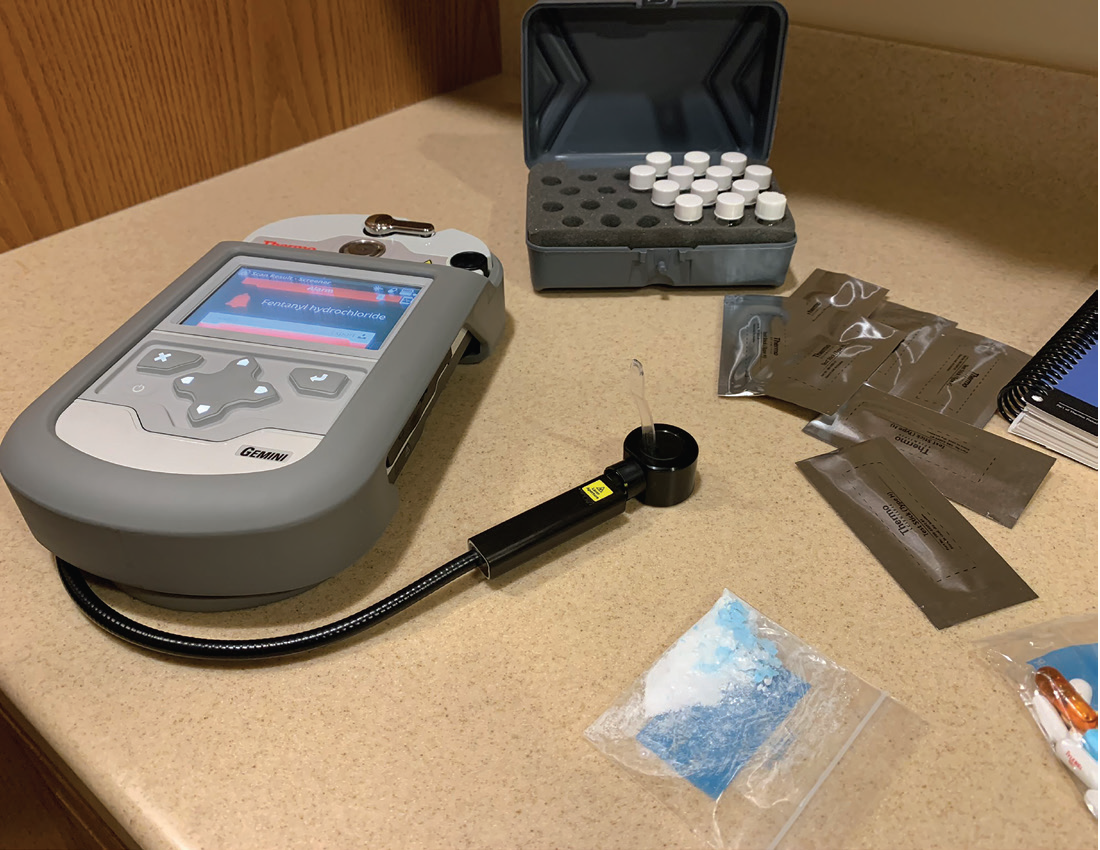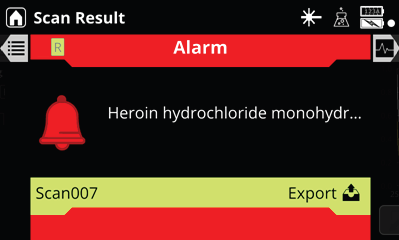Synthetic opioids represent a growing problem for law enforcement in their efforts to combat the illicit drug trade. The range of synthetic drugs and their analogs is continuously expanding, making it challenging for analyzer equipment to consistently identify new substances in the field.
Synthetic opioids, such as fentanyl, are relatively easy and inexpensive to synthesize, and these drugs are becoming increasingly potent. Consequently, the risk of overdosing is higher, and in many cases, fatalities occur accidentally due to the strength of the drug being unknown.
Heroin is another example of a potent, fast-acting opioid drug. Derived from morphine, a natural substance extracted from the seed of the opium poppy, heroin is 25 times more potent than its precursor and is distributed as a brown or white powder.
By comparison, synthetic fentanyl is 50 - 100 times more potent than morphine and is commonly manufactured in clandestine laboratories, making it cheaper and easier to obtain than heroin. In fact, the substance is often employed as a cutting agent or filler for heroin, making the risk of overdose greater for users who believe they are taking pure heroin.

Image Credit: Thermo Fisher Scientific – Portable and Handheld Raman Spectroscopy

Image Credit: Thermo Fisher Scientific – Portable and Handheld Raman Spectroscopy
Due to its strength, 2 - 3 milligrams of fentanyl can be lethal, roughly the size of 5 - 7 grains of salt. However, the synthetic opioid carfentanyl is estimated to be 100 times more potent than fentanyl, meaning as little as 0.00002 grams can be fatal.
Factors including inconsistent lab practices, drug costs, and availability mean the potency of pure synthetic drugs and drug mixes is unpredictable, adding to the risk taken by drug users.
High-potency synthetic opioids can be trafficked easily across a distribution network in very small quantities, referred to as micro-trafficking. Using several agents to transport barely detectable packets of potent, synthetic drugs is a more effective trafficking strategy than smuggling bricks of less potent drugs across borders.

Image Credit: Thermo Fisher Scientific – Portable and Handheld Raman Spectroscopy
This mode of trafficking finished products is becoming increasingly common in the US, with fewer cases of bulk raw material being smuggled into the country, representing a rapid shift in strategy. As a result, staying ahead of emerging trends in the production, distribution, and trafficking of narcotics is a key focus of interdiction forces such as US Customs and Border Protection (CBP).
Detection difficulties
The Thermo Scientific™ Gemini™ Analyzer is a sophisticated drug analysis instrument and one of the primary tools used by law enforcement to detect illicit substances in the field.
The Gemini analyzer is the only handheld instrument on the market that incorporates both Fourier transform infrared (FTIR) and Raman spectroscopies in a single unit. These complimentary techniques allow the operator to better identify unknown substances in the field.
FTIR and Raman spectroscopy are exceptional analytical techniques for identifying illicit drugs in both pure form and high concentrations in mixtures. The techniques are also user-friendly and highly accurate, with editable libraries of hundreds of drug signatures stored in each unit for rapid identification of drugs, analogs, and precursors.
The recent rise of low concentration (1 - 10 wt. %) trafficking of drugs, including fentanyl and its analogs, as well as heroin in powdered mixtures and pills, has posed a problem for standard, bulk detection spectroscopies such as FTIR and Raman (reliable at concentrations above 10 wt. %). Therefore, the detection of micro-trafficked substances is at the edge of the effective range for Raman and FTIR.
LowDoseID
To boost the effectiveness of Gemini for detecting low drug concentrations, Thermo Fisher has developed LowDoseID™. This new upgrade has introduced the SERS- (surface-enhanced Raman spectroscopy) based H-Kit capability and a second Raman spectrum identification algorithm called Screener.
SERS, also referred to as surface-enhanced Raman scattering, is not a new technique; however, when employed in combination with the existing capabilities of the analyzer, regular and reliable identification of concentrations below 10 wt. % becomes possible. In some cases, chemicals in concentrations as low as 1 wt. % are detectable, giving the techniques close to trace capability.
SERS is not as effective as lab-based mass spectrometry; however, the technique can be easily employed in the field, can also be used for bulk detection, and is anti-fluorescent.

Image Credit: Thermo Fisher Scientific – Portable and Handheld Raman Spectroscopy
SERS-based H-Kit
SERS operates by absorbing molecules of a substance onto the surfaces of nanostructures, such as nanoparticles or roughened metal surfaces (typically gold or silver).
The absorbed molecules produce an enhanced Raman scattering signal when illuminated by a typical Raman spectrometer laser, several orders of magnitude larger than a “normal” Raman signal. This allows for the detection of low concentrations of illicit drugs in mixtures and pills.
Screener algorithm
In addition to the standard Raman spectrum identification (ID) algorithm used by the Gemini analyzer, LowDoseID includes a second Raman spectrum analysis algorithm called Screener.

Image Credit: Thermo Fisher Scientific – Portable and Handheld Raman Spectroscopy
The algorithm is very similar to that employed by the Thermo Scientific™ TruNarc™ Analyzer and was developed to identify both pure drugs and drugs in mixtures.
Rather than identifying unknown substances like the standard ID algorithm, the Screener algorithm searches for substances of interest. This algorithm can analyze both normal Raman spectra and SERS H-Kit spectra and utilizes an Alert Configuration file containing the substances of interest.
The pre-loaded default Alert Configuration file contains approximately 600 common illicit drugs, drug precursors, and cutting agents. The operator can develop a customized file by modifying this default file. Substances can be moved between the classifications, added to the file from the instrument’s 12,700+ item Raman factory library or from a user-generated library.

Image Credit: Thermo Fisher Scientific – Portable and Handheld Raman Spectroscopy
The LowDoseID Raman factory library contains more than 700 illicit drugs, including heroin, fentanyl, cocaine, fentanyl analogs, methamphetamine, synthetic opioids, synthetic cannabinoids, phenethylamines, and cathinones, as well as numerous precursors and many different cutting agents.
Conclusions
A low concentration of synthetic drug can be just as dangerous as a bulk quantity of illicit material; however, detection of such low quantities, even with sophisticated analyzer equipment, is much more challenging.
With low concentrations of dangerous drugs becoming increasingly common, the Gemini Analyzer with LowDoseID is a valuable addition to the analytical detection and identification toolbox of law enforcement and border protection and will help save lives.
About Thermo Fisher Scientific – Portable and Handheld Raman Spectroscopy
Thermo Fisher Scientific offers innovative solutions that help our customers solve complex analytical challenges, accelerate life sciences manufacturing, deliver medicines to market, and increase laboratory productivity. Our Thermo Scientific portable and handheld process Raman analyzers enable accurate, real-time results for process monitoring.
The Thermo Scientific™ MarqMetrix™ All-In-One Process Raman Analyzer is an all-in-one system purpose-built for rapid deployment, ease of use, and scalability in markets where time-to-results is critical. The MarqMetrix All-In-One Process Raman Analyzer is designed for:
- Analysis without sample preparation, delivering Raman spectral results in real-time
- Easy setup and deployment by non–Raman spectroscopists
- Non-destructive workflows to protect precious samples
- Non-invasive handling to minimize contamination of samples
- Small footprint for convenient deployment
- Factory calibration for hardware stability and portability
Our Thermo Scientific TruScan™ Handheld Raman Analyzers includes state-of-the-art optics paired with a patented multivariate residual analysis that offers an effective chemometric solution for material identification, with two spectral pre-processing options. The non-destructive point-and-shoot sampling principle facilitates rapid verification of a broad range of chemical compounds, including cellulose-based products.
The TruScan™ G3 Handheld Raman Analyzer continues the evolution of raw material ID testing for pharmaceutical and biotechnology manufacturing quality control processes with:
- Incoming raw material identification (RMID)
- Dispensing of materials during API manufacture
- Finished product inspection
- Identification of falsified (counterfeit) medicines
- Enables non-technical operators to rapidly perform raw material ID testing without the need of a lab
The TruScan™ RM Handheld Raman Analyzer takes pharmaceutical manufacturing QA/QC to the next level with:
- Enhanced 21 CFR Part 11 and cGMP compliance with biometric login, complex password options, and full audit trail features
- Non-contact analysis through plastic bags, glass containers, blister packs and clear gel caps
- Intuitive workflow adapted to production environment through PDF batch reports and ease of data input using barcode scanners
- Easy fleet management feature that enables cloning of instruments and identification methods
Sponsored Content Policy: News-Medical.net publishes articles and related content that may be derived from sources where we have existing commercial relationships, provided such content adds value to the core editorial ethos of News-Medical.Net which is to educate and inform site visitors interested in medical research, science, medical devices and treatments.